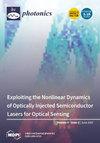The Suppression Effect of an Imaging System on the Geometric Tilt-to-Length Coupling in a Test Mass Interferometer
IF 2.1
4区 物理与天体物理
Q2 OPTICS
引用次数: 0
Abstract
Tilt-to-length (TTL) coupling noise arises from angular misalignments of interfering beams in optical path length (OPL) measurements and significantly impacts the accuracy of interferometry measurement systems. This paper focuses on geometric TTL coupling in a test mass (TM) interferometer and examines how an imaging system influences TTL noise suppression. First, the analytical expression of the geometric TTL coupling in a TM interferometer with alignment errors is derived and confirmed through numerical simulation. Subsequently, an imaging system is incorporated into the geometric model and the corresponding analytical expressions are obtained under two common conjugate relationships. Nevertheless, the TTL coupling remains beyond the requirement of TM interferometer, as the residual TTL coupled with alignment errors persists even with the imaging system. Therefore, an optimal position of the imaging system capable of eliminating the second-order term of the TTL coupling is determined. Meanwhile, the first-order term can be mitigated through in-orbit calibrations. These findings offer valuable guidance for the design and adjustment of imaging systems in space-borne gravitational wave detection missions, which require high-precision laser interferometry.成像系统对试验质量干涉仪几何倾斜-长度耦合的抑制效应
倾斜-长度(TTL)耦合噪声产生于光路径长度(OPL)测量中干涉光束的角度偏差,严重影响干涉测量系统的精度。本文重点讨论测试质量(TM)干涉仪中的几何 TTL 耦合,并研究成像系统如何影响 TTL 噪声抑制。首先,推导出具有对准误差的 TM 干涉仪中几何 TTL 耦合的分析表达式,并通过数值模拟加以确认。随后,在几何模型中加入了成像系统,并根据两个共轭关系得到了相应的分析表达式。尽管如此,TTL 耦合仍然超出了 TM 干涉仪的要求,因为即使有了成像系统,与对准误差耦合的残余 TTL 仍然存在。因此,需要确定成像系统的最佳位置,以消除 TTL 耦合的二阶项。同时,一阶项可以通过在轨校准来减轻。这些发现为需要高精度激光干涉测量的空间引力波探测任务中成像系统的设计和调整提供了宝贵的指导。
本文章由计算机程序翻译,如有差异,请以英文原文为准。
求助全文
约1分钟内获得全文
求助全文
来源期刊

Photonics
Physics and Astronomy-Instrumentation
CiteScore
2.60
自引率
20.80%
发文量
817
审稿时长
8 weeks
期刊介绍:
Photonics (ISSN 2304-6732) aims at a fast turn around time for peer-reviewing manuscripts and producing accepted articles. The online-only and open access nature of the journal will allow for a speedy and wide circulation of your research as well as review articles. We aim at establishing Photonics as a leading venue for publishing high impact fundamental research but also applications of optics and photonics. The journal particularly welcomes both theoretical (simulation) and experimental research. Our aim is to encourage scientists to publish their experimental and theoretical results in as much detail as possible. There is no restriction on the length of the papers. The full experimental details must be provided so that the results can be reproduced. Electronic files and software regarding the full details of the calculation and experimental procedure, if unable to be published in a normal way, can be deposited as supplementary material.
 求助内容:
求助内容: 应助结果提醒方式:
应助结果提醒方式:


